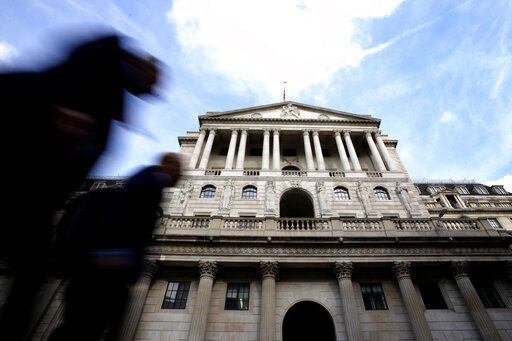LONDON — Britain’s central bank raised its key interest rate today by another half-percentage point to the highest level in 14 years, but it avoided more aggressive steps to tame inflation that the U.S. Federal Reserve and other banks have taken.
It is the Bank of England’s seventh straight move to increase borrowing costs as rising food and energy prices fuel a cost-of-living crisis that is considered the worst in a generation. Despite facing a slumping currency, tight labor market and inflation near its highest level in four decades, officials decided against acting more boldly as they predicted a second consecutive drop in economic output this quarter, a long-held informal definition of recession.
The bank matched its half-point increase last month — the biggest in 27 years — to bring its benchmark rate to 2.25%. The decision was delayed for a week as the United Kingdom mourned Queen Elizabeth II and comes after new Prime Minister Liz Truss’ government unveiled a massive relief package aimed at helping consumers and businesses cope with skyrocketing energy bills.
The measures eased uncertainty over energy prices and are “likely to limit significantly further increases” in consumer prices, the bank’s policymakers said. They expected inflation to peak at 11% in October, lower than previously forecast.
“Nevertheless, energy bills will still go up and, combined with the indirect effects of higher energy costs, inflation is expected to remain above 10% over the following few months, before starting to fall back,” the monetary policy committee said.
The U.K. decision comes during a busy week for central bank action marked by much more aggressive moves to bring down soaring consumer prices.
The U.S. Federal Reserve hiked rates Wednesday by three-quarters of a point for the third consecutive time and forecast that more large increases were ahead. Also Thursday, the Swiss central bank enacted its biggest-ever hike to its key interest rate.
Surging inflation is a worry for central banks because it eats away at consumers’ purchasing power. The traditional tool to combat inflation is raising interest rates, which reduces demand and therefore prices, by making it more expensive to borrow money.
Inflation in the United Kingdom is running at 9.9%, close to its highest level since 1982 and five times higher than the Bank of England’s 2% target. The British pound is at its weakest against the dollar in 37 years, contributing to imported inflation.
To ease the crunch, Truss’ government announced it would cap energy bills for households and businesses that have soared as Russia’s war in Ukraine drives up the price of natural gas needed for heating.
The Treasury is expected to publish a “mini-budget” Friday with more economic stimulus measures, and the bank said it won’t be able to assess how they will affect inflation until its next meeting in November.
The Bank of England expects gross domestic product to fall by 0.1% in the third quarter, below its August projection of 0.4% growth. That would be a second quarterly decline after an Office of National Statistics estimate that output had fallen by 0.1% in the second quarter.
The bank avoided pressure to go bigger even as other banks around the world take aggressive action against inflation fueled by the global economy’s recovery from the COVID-19 pandemic and then the war in Ukraine.
This month, Sweden’s central bank raised its key interest rate by a full percentage point, while the European Central Bank delivered its largest-ever rate increase with a three-quarter point hike for the 19 countries that use the euro currency.


